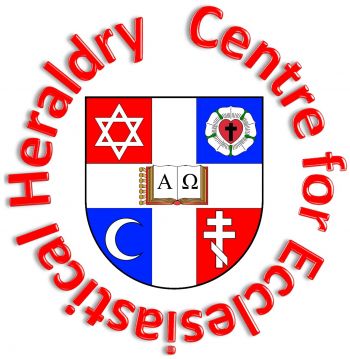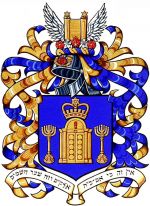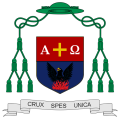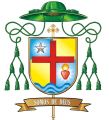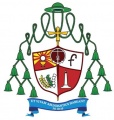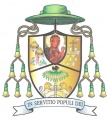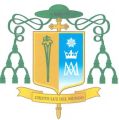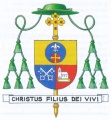Centre for Ecclesiastical Heraldry: Difference between revisions
Knorrepoes (talk | contribs) |
Knorrepoes (talk | contribs) m (Text replacement - " :" to ":") |
||
| (4 intermediate revisions by the same user not shown) | |||
| Line 14: | Line 14: | ||
None of the major (Christian) churches, Catholic, Anglican, Orthodox or Lutheran, currently has a heraldic authority, but all have a long heraldic tradition. The ecclesiastical heraldic tradition has developed in the Catholic Church since the 13th century and spread among other religions worldwide. | None of the major (Christian) churches, Catholic, Anglican, Orthodox or Lutheran, currently has a heraldic authority, but all have a long heraldic tradition. The ecclesiastical heraldic tradition has developed in the Catholic Church since the 13th century and spread among other religions worldwide. | ||
[[File:Copenhagen-martensen | [[File:Copenhagen-martensen.png|150 px|center]] | ||
The '''Catholic Church''' has some basic regulations for the external ornaments for Bishops, Cardinals and other prelates. But no general guidelines on heraldic design of arms for (parishes, (arch)dioceses or prelates. In some countries | The '''Catholic Church''' has some basic regulations for the external ornaments for Bishops, Cardinals and other prelates. But no general guidelines on heraldic design of arms for (parishes, (arch)dioceses or prelates. In some countries a heraldic tradition has developed locally based on local traditions and heraldic authorities, whereas in other countries there are no regulations or guidelines. | ||
[[File:Anglican diocese of Mauritius.jpg|150 px|center]] | [[File:Anglican diocese of Mauritius.jpg|150 px|center]] | ||
| Line 32: | Line 32: | ||
<gallery perrow=0> | <gallery perrow=0> | ||
File:Montevideo-gonzalez.jpg | File:Montevideo-gonzalez.jpg | ||
File:Rancagua | File:Rancagua.png | ||
File:Sjosec-teixeira.jpg | File:Sjosec-teixeira.jpg | ||
File:Surabaya-wisaksono.jpg | File:Surabaya-wisaksono.jpg | ||
| Line 38: | Line 38: | ||
File:Diocese on the Niger.jpg | File:Diocese on the Niger.jpg | ||
File:Umzimkulu-dziuba.jpg | File:Umzimkulu-dziuba.jpg | ||
File:Tlapa-sosa.jpg | |||
</gallery> | </gallery> | ||
| Line 59: | Line 60: | ||
The platform has no formal structure, but when we receive a request, this will be circulated among the members and one or more members take up the project. | The platform has no formal structure, but when we receive a request, this will be circulated among the members and one or more members take up the project. | ||
Examples of our designs : | Examples of our designs: | ||
<gallery perrow=> | <gallery perrow=> | ||
File:utrecht-woorts.rel.jpg|Mgr Woorts (design Hans van Heijningen) | File:utrecht-woorts.rel.jpg|Mgr Woorts (design Hans van Heijningen) | ||
| Line 68: | Line 69: | ||
==Information, requests and orders== | ==Information, requests and orders== | ||
If you would like the request the help of the Centre for Ecclesiastical Heraldry, or have your existing arms registered, please contact us at:<br> | If you would like the request the help of the Centre for Ecclesiastical Heraldry, or have your existing arms registered, please contact us at:<br> | ||
* [mailto:ceh@ngw.nl e-mail] (in English, French, Spanish, German, Swedish, Norwegian, Danish, Czech or Slovak) | * [mailto:ceh@ngw.nl e-mail] (in English, French, Spanish, Italian, German, Swedish, Norwegian, Danish, Czech or Slovak) | ||
or | or | ||
Latest revision as of 10:35, 29 July 2024
CENTRE FOR ECCLESIASTICAL HERALDRY
The Centre for Ecclesiastical Heraldry is an international, non-denominational and non-profit platform of (amateur) heraldists interested in ecclesiastical heraldry.
The CEH will help any religious person or organisation in their process of acquiring a coat of arms for him/herself or the organisation. This can be for a parish priest, a deacon, a vicar, a parish, a bishop, a cardinal etc. We work for all major religions and observe the accepted rules and regulations of the respective church and local heraldic authorities (if present).
The CEH is also responsible for the Ecclesiastical heraldry part of the Heraldry of the World website, which aims to create as much awareness and interest of heraldry worldwide.
Why a Centre for Ecclesiastical Heraldry ?
None of the major (Christian) churches, Catholic, Anglican, Orthodox or Lutheran, currently has a heraldic authority, but all have a long heraldic tradition. The ecclesiastical heraldic tradition has developed in the Catholic Church since the 13th century and spread among other religions worldwide.
The Catholic Church has some basic regulations for the external ornaments for Bishops, Cardinals and other prelates. But no general guidelines on heraldic design of arms for (parishes, (arch)dioceses or prelates. In some countries a heraldic tradition has developed locally based on local traditions and heraldic authorities, whereas in other countries there are no regulations or guidelines.
The Anglican church also has a longtime heraldic tradition dating from the 16th century, but, like the Catholic Heraldry, has no worldwide rules or regulations. As the Anglican church is primarily based in the UK and Commonwealth countries, heraldic traditions are generally covered by the local heraldic authorities (f.e. College of Arms in England, Lord Lyon in Scotland and the Canadian Heraldic Authority).
The Lutheran church has no central or general rules on heraldry. In some countries, f.e. Sweden, an proper system of heraldry has been developed based on the national heraldic guidelines, but this is not the case for other countries.
In Judaism very few heraldic examples are known, and in Islam, Hinduism or other Asian religions heraldry is (still) practically absent.
This lack of heraldic authority has resulted in a very diverse range of heraldic and pseudo-heraldic designs and (local) systems. The Centre for Ecclesiastical Heraldry would like to overcome this by advising any religious person or body on proper heraldic designs and can also help to design and develop a local heraldic style and hierarchy.
Some examples of pseudo- or (very) poor heraldry, most of which can be redesigned rather easily to a proper heraldic coat of arms with the help of the Centre for Ecclesiastical Heraldry.
What can we do ?
- We will advise in designing a coat of arms for any person or organisation of all religions.
- We will provide a design based on the wishes of the client and according to local heraldic regulations.
- The final design will be made available to the bearer by transferring copyrights.
- The design will be free of charge, unless the client requires very extensive work. In these cases a quotation of expenses will be sent beforehand to the client.
- The final design and meaning will be published at Heraldry of the World.
- We will work fully digital, we will not travel to the client, unless really necessary. In those cases the client will bear the travel costs.
We will not:
- Design non-heraldic materials
- Print or produce any material with the coat of arms, we will only make the design
- Register the arms in an official heraldic authority in countries where such is required/advised (UK, Canada..)
Members
The individual members of the platform have a longtime knowledge of heraldry and designing coats of arms for religious and non-religious persons or organisations.
The platform has no formal structure, but when we receive a request, this will be circulated among the members and one or more members take up the project.
Examples of our designs:
Information, requests and orders
If you would like the request the help of the Centre for Ecclesiastical Heraldry, or have your existing arms registered, please contact us at:
- e-mail (in English, French, Spanish, Italian, German, Swedish, Norwegian, Danish, Czech or Slovak)
or
Centre for Ecclesiastical Heraldry
c/o Busehof 7
6871 BM Renkum
The Netherlands
